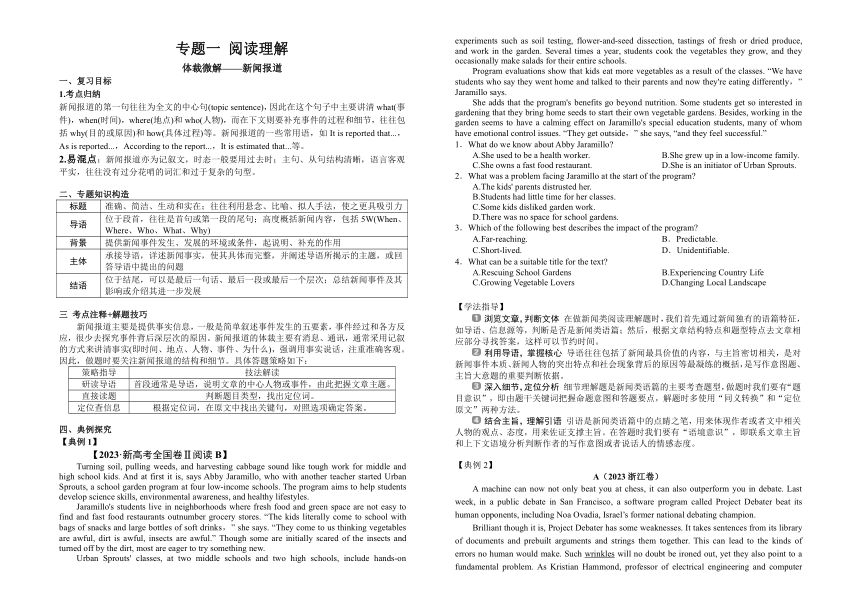
专题一 阅读理解 体裁微解———新闻报道 一、复习目标 1.考点归纳 新闻报道的第一句往往为全文的中心句(topic sentence),因此在这个句子中主要讲清what(事件),when(时间),where(地点)和who(人物),而在下文则要补充事件的过程和细节,往往包括why(目的或原因)和how(具体过程)等。新闻报道的一些常用语,如It is reported that...,As is reported...,According to the report...,It is estimated that...等。 2.易混点:新闻报道亦为记叙文,时态一般要用过去时;主句、从句结构清晰,语言客观平实,往往没有过分花哨的词汇和过于复杂的句型。 2、专题知识构造 标题 准确、简洁、生动和实在;往往利用悬念、比喻、拟人手法,使之更具吸引力 导语 位于段首,往往是首句或第一段的尾句;高度概括新闻内容,包括5W(When、Where、Who、What、Why) 背景 提供新闻事件发生、发展的环境或条件,起说明、补充的作用 主体 承接导语,详述新闻事实,使其具体而完整,并阐述导语所揭示的主题,或回答导语中提出的问题 结语 位于结尾,可以是最后一句话、最后一段或最后一个层次;总结新闻事件及其影响或介绍其进一步发展 三 考点注释+解题技巧 新闻报道主要是提供事实信息,一般是简单叙述事件发生的五要素,事件经过和各方反应,很少去探究事件背后深层次的原因。新闻报道的体裁主要有消息、通讯,通常采用记叙的方式来讲清事实(即时间、地点、人物、事件、为什么),强调用事实说话,注重准确客观。因此,做题时要关注新闻报道的结构和细节。具体答题策略如下: 策略指导 技法解读 研读导语 首段通常是导语,说明文章的中心人物或事件,由此把握文章主题。 直接读题 判断题目类型,找出定位词。 定位查信息 根据定位词,在原文中找出关键句,对照选项确定答案。 四、典例探究 【典例1】 【2023·新高考全国卷Ⅱ阅读B】 Turning soil, pulling weeds, and harvesting cabbage sound like tough work for middle and high school kids. And at first it is, says Abby Jaramillo, who with another teacher started Urban Sprouts, a school garden program at four low income schools. The program aims to help students develop science skills, environmental awareness, and healthy lifestyles. Jaramillo's students live in neighborhoods where fresh food and green space are not easy to find and fast food restaurants outnumber grocery stores. “The kids literally come to school with bags of snacks and large bottles of soft drinks,” she says. “They come to us thinking vegetables are awful, dirt is awful, insects are awful.” Though some are initially scared of the insects and turned off by the dirt, most are eager to try something new. Urban Sprouts' classes, at two middle schools and two high schools, include hands on experiments such as soil testing, flower and seed dissection, tastings of fresh or dried produce, and work in the garden. Several times a year, students cook the vegetables they grow, and they occasionally make salads for their entire schools. Program evaluations show that kids eat more vegetables as a result of the classes. “We have students who say they went home and talked to their parents and now they're eating differently,” Jaramillo says. She adds that the program's benefits go beyond nutrition. Some students get so interested in gardening that they bring home seeds to start their own vegeta ... ...
~~ 您好,已阅读到文档的结尾了 ~~